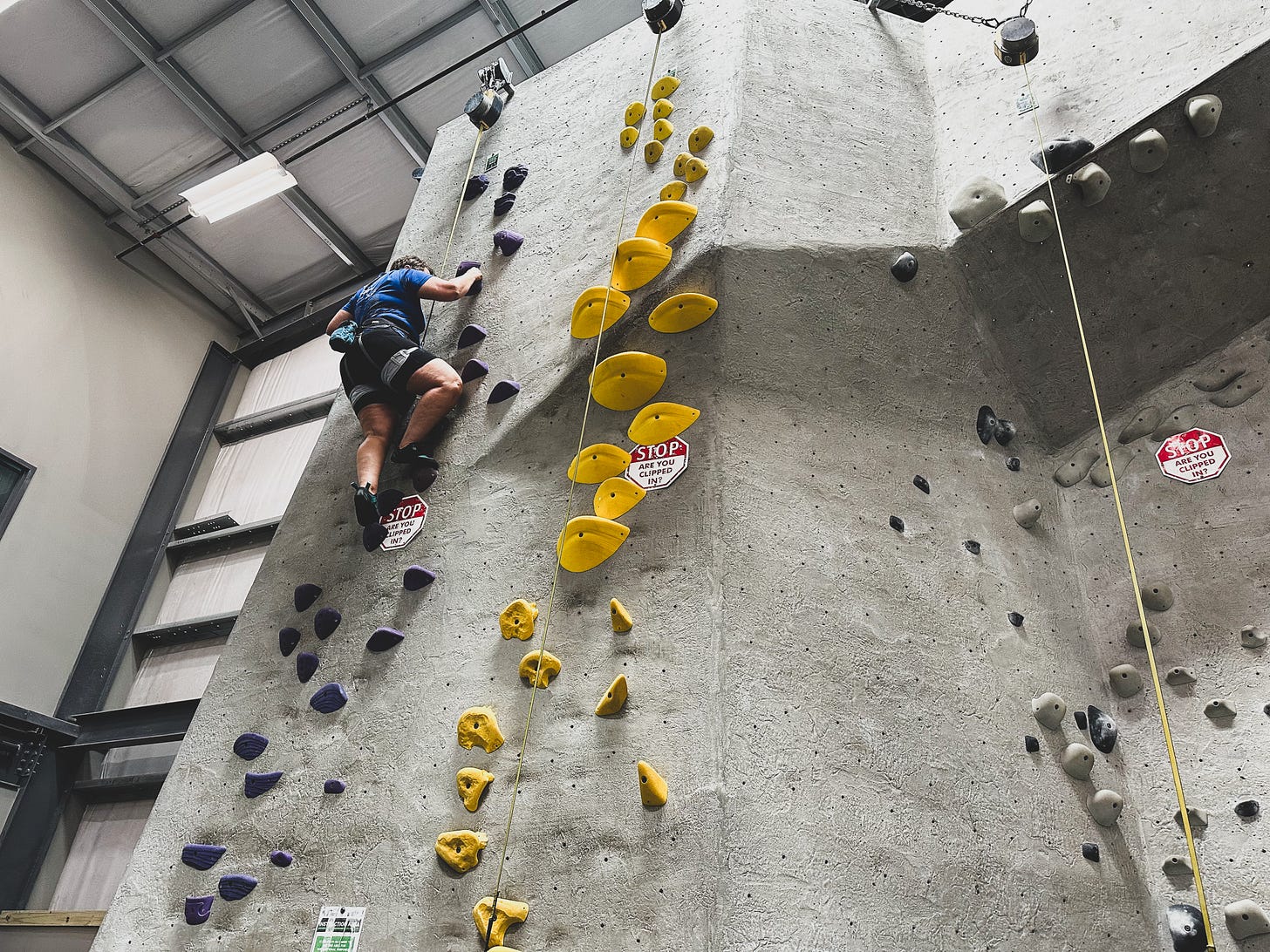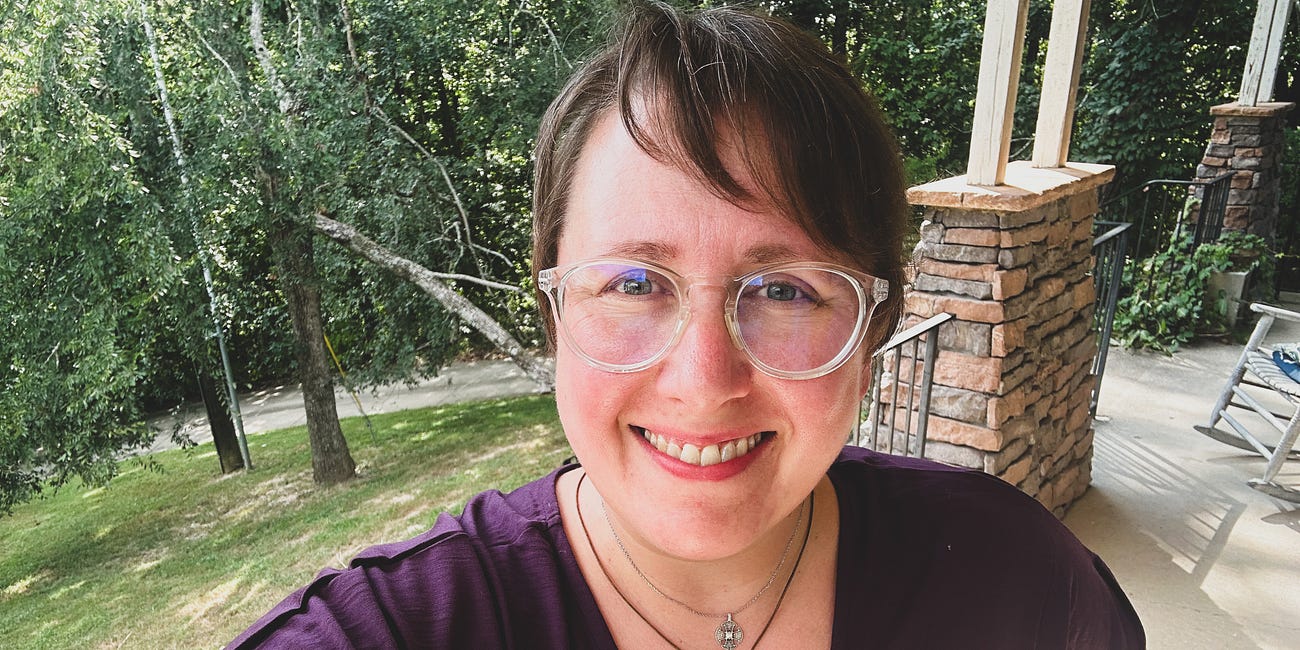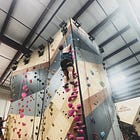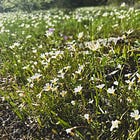A Bit Late
If there’s something you’ve thought, gee I’ve always wanted to try that, go for it.
In keeping with my latest obsession, I’ve been looking for female climbers to follow on social media for tips, something that is harder to do than you might think judging by all the recommended reels featuring predominately white male climbers in their 20s and 30s with lean ropy muscles and six packs. But as with most things, there’s more diversity than the algorithms or indeed even the first glance at my new climbing gym would imply.
There most of the staff fits into the stereotype. I’ve seen one female staffer so far, but not really interacted with her. The young, male staffers have responded variously to me, from being enthusiastic when I said I’d invested in my own gear, to joking about setting the auto-belay to “assisted climb” when I said something about tightening the one that makes you take a trust fall before it catches. Maybe he would have said that to anyone. Maybe I’m being self-conscious as a solid, almost forty-six year old starting a new hobby.
The second female climber I came across on socials told a little bit of her story in one of her reels. She said, “I started climbing at twenty-five, so a bit late…” of course in the context–she’s a competitive climber now at twenty-eight–I can see that perhaps most competitive climbers, like many professional athletes, started their sport as children. But still the phrasing made me snort. Starting something at twenty-five is “a bit late.”
I thought that too for about five minutes when I wanted to start backpacking. I started reading stories and it seemed like most thru-hikers were late teens to early twenties and I briefly thought, oh, I’ve missed my chance. And then I read Emma Gatewood’s story. After surviving an horrifically abusive relationship, obtaining one of the first divorces for it in her area, and raising all her children to adulthood, she sent word she was going for a walk. And she traveled to Mt. Oglethorpe, then the southern terminus of the Appalachian Trail, and began walking north. Equipped with white canvas Keds, a denim sack she sewed herself and balanced on her shoulder in lieu of a backpack, a walking stick and an army canteen, she not only became the first woman to thru-hike the Appalachian trail, she did it at the age of 67, in 1955. She had no cell service, no GPS. She slept wrapped up in a wool army surplus blanket and a shower curtain for rain protection. When it was too cold for just her blanket, she heated rocks in the fire and slept on top of them. She is looked at as the pioneer of ultra-light, minimalistic backpacking, and all she did was decide to go for a walk. One hundred and forty-six days later, she emerged in Maine victorious.
I was forty-one when I read that story, and I thought, well, if I start backpacking now, I’ll have twenty-six years of experience under my belt by the time I’m the age she started.
I was playing with my kids in the pool the other day, and thinking back to when I was a kid spending summers at the community pool. I don’t remember my mom playing with us. I remember her getting in the water to cool off and we would swim around her and use her legs like a tunnel to swim between. We took swim lessons from an early age because she had been a lifeguard in her teens and prioritized swimming safety. She also was the one who taught me how to rescue swim and side stroke. How to tow a victim to safety and how to get them to stop climbing on you if they’re panicked when you get to them.
My dad taught me how to tie a double half hitch when he was making a rope bridge and “lookout seat” as an extension to our treehouse. Of course, nominally, he said the bridge and seat were for my brother. Since I was a girl, I was supposed to stay in the porch-like structure with the big solid ladder to get in and out of it. But I never thought too highly of those sorts of delineations, and was out on the rope bridge as fast as he could get it completed. Those three pieces of rope suspended about four feet off the ground were transformed into a myriad of different uses as we played from fraying jungle suspension bridges to the rigging of a ship on stormy seas. I always pushed the boundaries of their prescribed roles for me, always looking for adventure, real or imagined.
As I toweled myself off, I made plans to go hiking with my youngest, and also told both kids they're coming climbing with me soon. I know enough now to teach them a few things and they can be more successful faster that way, even though no one taught me, I dove in and found videos with techniques to practice.
When my mom was 46, I was 21, and even though she’d had kids younger than I’d had them, all the things she talked about doing were already in the past. She used to run, she used to play field hockey, she used to be a lifeguard. Same for my Dad. He used to rock climb, he used to hike, he used to explore caves. They had been active people with hobbies and interests, but somehow by their thirties that contracted to the occasional day hike and making sure we had swim lessons. All of the adventures they’d had were in the past. This was a couple who decided to move to Alaska because they thought it would be an adventure, and drove a white panel truck and an ancient suburban towing a twenty-seven foot travel trailer up the Alcan into Alaska to do it. And this was before the Alcan was paved. Through mountain passes, all on gravel. They arrived, found work, bought a little plot of land, and built a house. And then they just stopped. I guess if you count the traveling they and later all of us did, they still had a little of the adventurous spirit, but I remember them telling stories about what they used to do, and staring at them, trying to picture them doing it, and failing. I stared into the grainy prints and blurry slides of their adventures and couldn’t make them come alive.
I don’t want that for my kids. I want my stories to be about the hiking trip I just came back from. I want them to see me paddleboarding, climbing, hiking, swimming in waterfall pools, trying new things and failing my way forward at all ages of my life. I want them and others to see that it’s not too late to try something, even if you land on your butt repeatedly coming off a climbing wall. I see stories of women who started running in their sixties and who are claiming titles in their nineties. And I don’t just think, good for her, I think, of course. Of course we should be trying new things, of course we should be learning, failing, and figuring it out. This is fundamentally human.
So if there’s something you’ve thought, gee I’ve always wanted to try that, go for it. Chances are, it’s not too late.
I Don't Fit the Box
A couple weeks ago I chopped off most of my hair. After several years of wearing it long enough to go past my shoulders, I’d had enough. Even though my hair was long, I could probably count on both hands the number of times I’d worn it down in four years. Most of the time, I had it pulled up and doubled in a hair elastic so none of it would actually touch my face. It was one of those things I was aware of, but hadn’t really sat with how much it was bothering me until it occurred to me I could do something about it.
“I wish I could still believe in God, but I can’t be a Christian anymore because of ______” Fill-in-the-blank with racism, misogyny, homophobia, toxic capitalism, and so on. I’ve had this conversation with different people almost word-for-word over and over. White American Christianity has so defined God that many people cannot separate God from the toxic theology they were taught.
But this isn’t the God I see in the Bible. The Bible shows us a God meeting people where they are and nudging them towards justice and total thriving for all: shalom. The Bible details arcs of justice and societal reform. If we understand how radical those arcs were in the context of the day, we can extend them forward into the future and figure out how to work for justice, total thriving, and societal reformation in our day.
I grew up in that first world view. Come along, and I’ll tell you the story of how I escaped, and I’ll show you a theology that I believe paints a more accurate picture: a faith for the common good where everyone thrives and no one is left out.
Purchase
Wipf and Stock | Order through your favorite Indie bookstore | Amazon
Connect
Anna Elisabeth Howard writes highly caffeinated takes on shalom as a lens for everything from her front porch in Hendersonville, TN where she lives with her husband and two sons. She is a community organizer and movement chaplain with a background in youth and family ministry and is a graduate of Fuller Theological Seminary. An avid hiker and backpacker, many thoughts start somewhere in the middle of the woods, or under a waterfall. She is a regular contributor to Earth & Altar and her latest book is Inward Apocalypse: Uncovering a Faith for the Common Good.
Buy Inward Apocalypse: Amazon | Independent Booksellers
Social media: Facebook | Instagram
Join the subscriber chat! If you already have the app, just go to the new chat section, if not, download the app here.
I’m one of the facilitators of Freedom Road’s Global Writers’ Group. If you’ve been looking for a community of writers to boost you to the next step of your writing goals—wherever you are in that process—join us!











